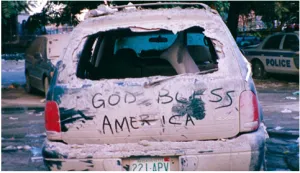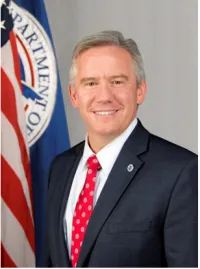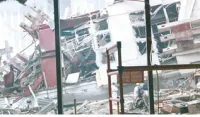 FAMS Special Agent in Charge Eric Sarandrea wrote “God Bless America” on this car near Ground Zero the day after the 9/11 attacks. (Eric Sarandrea photo)
FAMS Special Agent in Charge Eric Sarandrea wrote “God Bless America” on this car near Ground Zero the day after the 9/11 attacks. (Eric Sarandrea photo)
Editor’s Note: Eric Sarandrea is the Supervisory Air Marshal in Charge (SAC) for the Federal Air Marshal Service (FAMS) Washington Field Office. Sarandrea, who started as a Federal Air Marshal (FAM) in 1998 under the Federal Aviation Administration, worked as a criminal investigator for the Department of Education’s Office of Inspector General near the World Trade Center on 9/11. Below, he describes that tragic day and the aftermath of the attacks as he directed people away from the towers, helped set up a triage site across the street from Ground Zero, and aided first responders by placing victims in ambulances.
After 9/11, Sarandrea helped restore confidence in the nation’s air travel system. As one of four FAMs who led the standup of FAMS Flight Operations, he helped create and implement a system from the ground up by scheduling several thousand newly hired FAMs on high-risk flights. On December 1, 2001, the Department of Education presented Sarandrea a certificate of excellence “in recognition of his courage and resolve on September 11, 2001, and his steadfast commitment to public service and his country.”
On September 11, 2001, I was a criminal investigator for the U.S. Department of Education, working across the street from the World Trade Center in New York City. I had recently taken on this assignment, having previously worked as a Federal Air Marshal at the Federal Aviation Administration (FAA).
My fellow employees and I were having coffee, discussing cases when American Flight 11 hit the north tower. Our office shook, and I was sure something was wrong. I evacuated my team from our building and found ourselves among crowds of people running away from the twin towers.
The West Side Highway became a sea of people and onlookers. I noticed a vehicle rocking back and forth from the debris falling from the twin towers, and I realized people needed to move away. I took on the role of directing large groups of people away from the falling debris.
There was a great deal of confusion. We were not aware of what was happening, whether it was terrorism or a fire. Then we heard another explosion, and an NYPD officer said he thought a missile had just struck one of the towers. It was actually United Flight 175 striking the south tower.
As time passed and fewer people came out of the building, I joined a team of U.S. Secret Service agents and set up a triage site across the street from the World Trade Center. It was at this time when the horror I saw could never be forgotten. I saw people falling from the building. I can never forget one man’s face and how he fell. It remains with me to this day.
I turned away and returned to setting up the triage area. As victims came out of the building, we put them in ambulances and prepared a site to aid the less injured. The senior special agent instructed us to use the phone in a nearby business to contact our family members. I'm not sure of the reasoning, but it was an essential task since our cell phones were not working.
I contacted my wife, who worked at the Empire State Building, and instructed her to evacuate from the city and head home. I told her I was fine, and I would be here for a long time until the appropriate support arrived and could relieve us.
I remember putting a woman suffering from severe burns in an ambulance. From my military training, I kept repeating to her that she would be fine. As the ambulance drove away and maneuvered out of the falling debris, it ran over a no-parking sign. Soon after, everything changed.
I cannot recall the sound or what prompted me to run, but I began to run west from the triage site. I turned and saw a wall of debris following me. At the time, I could not comprehend what was happening – the south tower was collapsing – but I needed to run for my life. I reached the end of the street, turned south down a block, and was among several other survivors.
Within minutes, it changed from a beautiful day to a very dark blizzard of ashes. I briefly walked, but then I got lost and found a construction worker who gave me a mask. Then, I tried to work my way back to the World Trade Center. I found myself in front of the New York Stock Exchange on Wall Street. The ash was up to 6 inches deep on the street, and shoes were everywhere.
I heard the roar of a jet overhead, and I can remember the moment of fear and then happiness, knowing it was not a threat but a U.S. fighter jet. Somewhere along that walk, I received a push-to-talk signal on my Nextel phone and saw text messages from my supervisor and co-workers ordering me to evacuate the city.
It was then when the north tower collapsed. I say the towers collapsed, but it was not until I walked across the Brooklyn Bridge when I realized both towers were gone.
The next day, I returned to Ground Zero. We had left our offices open, and our firearms, evidence, and casework were not secure.
Overnight, 7 World Trade Center, which was near the north tower and my office, collapsed into the street in front of our building. My office was destroyed.
When I arrived, I took photographs of the office after gaining permission from the fire department to enter our building. I entered the building, secured our offices, and safely departed.
I wrote “God Bless America” with my finger through the soot on a car. It was a special moment for me and a few nearby NYPD officers and firemen. Our world had just been turned upside down.
I went over to the area where the triage site was the day before, and there was a mountain of debris there. I spoke to a few police officers and joined in the bucket brigade, helping move debris so searchers could get into the wreckage to find survivors.
I returned Friday to lead a protection detail for the Secretary of Education through Ground Zero. The schools in the impacted area were being used to support rescue efforts, and the Secretary wanted to see the devastation and thank the rescue workers.
The next day, I drove to the FAA Tech Center in New Jersey on a temporary duty location to stand up the new Federal Air Marshal Service. I never returned to my prior office nor assignment, and it was almost 12 years before I would return to Ground Zero.
By Eric Sarandrea, Federal Air Marshal Service, Transportation Security Administration



